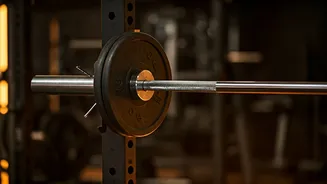Daily Squatting Overview
Incorporating squats into your daily regimen is a straightforward and highly effective method for enhancing overall physical health. Regular squatting
engages multiple muscle groups simultaneously, making it a comprehensive exercise. The beauty of squats lies in their accessibility; they require no specialized equipment and can be performed virtually anywhere. By dedicating just a few minutes each day, individuals can unlock a cascade of benefits, ranging from improved strength and flexibility to enhanced metabolic function. This routine can significantly improve overall physical well-being, proving that substantial improvements don't always require complicated routines or expensive gym memberships. Consistency is key when it comes to the benefits of daily squats, as their advantages accumulate over time. The simplicity of the exercise makes it highly adaptable to various fitness levels, ensuring that almost anyone can participate and reap its rewards. With proper form and a gradual increase in repetitions, squatting becomes a sustainable practice, easily integrated into any lifestyle.
Enhanced Muscle Strength
One of the primary advantages of daily squatting is its remarkable ability to build muscle strength. Squats are a compound exercise, meaning they work several muscle groups simultaneously. The primary muscles engaged include the quadriceps, hamstrings, and glutes, which contribute to the strengthening of the lower body. Additionally, squats involve core muscles that play a crucial role in stabilization and balance. Regular squatting fosters increased muscle mass and improves muscle endurance, which can enhance performance in various physical activities. By stimulating muscle fibers, squats contribute to muscle hypertrophy, the process of muscle growth. This, in turn, boosts metabolism and makes daily tasks easier. The progressive overload principle applies here: as you become stronger, you can gradually increase the number of repetitions or incorporate variations of squats to further challenge your muscles. This steady progression ensures continuous muscle development and strength gains. Over time, individuals will notice a visible difference in their lower body strength and overall muscular development.
Improved Flexibility & Mobility
Regular squatting dramatically improves flexibility and mobility, particularly in the lower body. Squats require a full range of motion, stretching and lengthening muscles like the hamstrings, hip flexors, and calves. By consistently moving through this range, you can reduce muscle stiffness and increase the overall suppleness of your body. This enhanced flexibility can significantly alleviate discomfort and the risk of injury. Moreover, better mobility makes everyday movements, such as walking, bending, and lifting, much easier and more efficient. Increased mobility also plays a critical role in preventing age-related decline in joint function. Consistent practice can lead to a greater range of motion, reducing the likelihood of developing conditions like arthritis. By regularly squatting, individuals can maintain and even enhance the flexibility needed for optimal physical performance, overall well-being and a healthier lifestyle. It's a fundamental part of maintaining joint health and reducing the impact of daily wear and tear.
Boosted Calorie Burn
Another significant benefit of daily squatting is its impact on calorie expenditure. As a compound exercise that involves a large number of muscles, squats boost metabolism, which helps burn calories more efficiently. Squatting leads to an increased heart rate and promotes fat loss. Regular squat sessions help create a higher metabolic rate, both during and after exercise, thereby aiding in weight management. This effect is especially beneficial for those looking to manage their weight or improve their body composition. The greater the muscle mass, the more calories are burned at rest. Squats support this by promoting muscle growth. By incorporating squats into your daily routine, you boost your body's ability to burn calories, contributing to weight loss and improved overall health. This can lead to a more effective fat-burning process and a higher resting metabolic rate, making it an excellent addition to any fitness plan aimed at weight management.
Enhanced Posture & Balance
Daily squatting significantly enhances posture and balance. Squats strengthen the core muscles that are vital for proper spinal alignment and support. The act of performing squats encourages the development of good posture, reducing the chance of slouching and improving overall body alignment. By strengthening core muscles, squats improve balance and coordination, making it easier to maintain stability during various activities. Better balance also reduces the risk of falls, particularly as you age, promoting safety and independence. Furthermore, the strengthening effect on the back muscles enhances spinal stability, reducing the likelihood of back pain. This improvement in posture and balance offers both aesthetic and functional benefits. Individuals often appear taller and more confident, while their ability to move and function in daily life improves dramatically. By regularly engaging in this exercise, one can actively promote and maintain excellent posture, contributing significantly to improved health and well-being.
How to Begin Safely
Starting a daily squat routine should be approached with careful consideration of safety and form. Begin by mastering the correct squat technique: feet shoulder-width apart, back straight, and core engaged. Ensure your knees do not extend past your toes. Start with a low number of repetitions, perhaps 5-10 squats, and focus on maintaining good form. If you're new to exercise, consult with a fitness professional who can guide you on proper form and modifications to minimize risk. Consider warming up before each session, incorporating dynamic stretches, like leg swings and arm circles. Listen to your body and avoid pushing yourself beyond your limits, especially during the initial stages. Gradually increase the number of repetitions or sets as your strength and endurance improve. Adding variations like sumo squats or goblet squats can enhance the effectiveness and target different muscle groups. Consistency is key, but so is listening to your body to prevent injuries. Starting slowly, prioritizing proper form, and gradually increasing intensity ensures a safe and effective path toward enhanced physical well-being.













